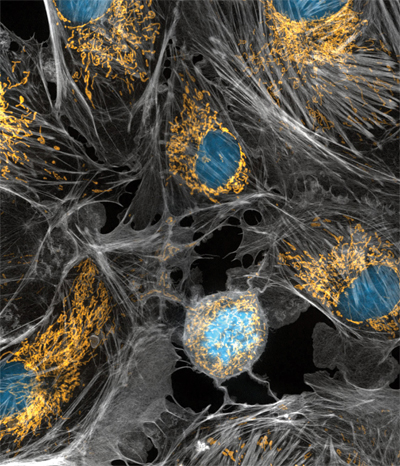MCP: When mitochondria make B cells go bad
B-cell chronic lymphocytic leukemia, or B-CLL, is the most common type of leukemia in adults and primarily affects elderly patients. The disease results from a patient’s bone marrow overproducing immature lymphocytes, a form of white blood cells that fight infections less effectively than their healthy counterparts but survive longer, ultimately overwhelming them and spreading unchecked. Unlike acute leukemia, B-CLL can take several years to cause problems for a patient, but it is less responsive to chemotherapy.
 When mitochondria, highlighted here in cow cells, suffer age-related oxidative damage, they can give rise to chronic lymphocytic leukemia.courtesy of Torsten Wittmann, University of California, San Francisco
When mitochondria, highlighted here in cow cells, suffer age-related oxidative damage, they can give rise to chronic lymphocytic leukemia.courtesy of Torsten Wittmann, University of California, San Francisco
While novel treatments have been developed in recent years, they only target the B cells once they’ve mutated to an immature, cancerous state. To develop treatments for B-CLL that might prevent B cells from becoming cancerous in the first place, researchers led by Christopher Gerner at the and have performed a comprehensive proteomics analysis of B-CLL cells and mature B cells in young and elderly patients. They described their work in the journal Â鶹´«Ă˝É«ÇéƬ & Cellular Proteomics.
“It could be nice to not only target the cancer cells, but those cells prone to becoming cancer cells,” Gerner said. “What we actually saw when we compared the young and the elderly donors was a very clear signature of mitochondrial stress and metabolic stress.”
Gerner and colleagues found that B-CLL cells have an increased expression of stem cell-associated molecules and a reduced expression of tumor-suppressing molecules and stress-related serotonin transporters as well as an observed increase in glutamine consumption and beta-oxidation of fatty acid.
This indicated that reactive oxidative species, which are carcinogenic and cause damage to cells, were being upregulated, Gerner said, which would explain why the incidence of mutations that lead to B-CLL increases with age. The researchers hope that the alterations in regulation also may provide a proteomic signature for immunosenescence, the immune system’s natural weakening with age.
Gerner and his fellow researchers plan to continue this research by performing their proteomic analysis on blood samples taken from greater numbers of healthy elderly people and B-CLL patients to ultimatelybe able to test when mitochondria have become predisposed for the disease.
“The pressure on those cells was simply different … and this pressure is something I would like to detect and measure in patients,” Gerner said. “That would be the ultimate aim.”
Enjoy reading ASBMB Today?
Become a member to receive the print edition four times a year and the digital edition weekly.
Learn moreGet the latest from ASBMB Today
Enter your email address, and we’ll send you a weekly email with recent articles, interviews and more.
Latest in Science
Science highlights or most popular articles

Elucidating how chemotherapy induces neurotoxicity
Andre Nussenzweig will receive the Bert and Natalie Vallee Award at the 2025 ASBMB Annual Meeting, April 12–15 in Chicago.

Where do we search for the fundamental stuff of life?
Recent books by Thomas Cech and Sara Imari Walker offer two perspectives on where to look for the basic properties that define living things.

UCLA researchers engineer experimental drug for preventing heart failure after heart attacks
This new single-dose therapy blocks a protein that increases inflammation and shows promise in enhancing muscle repair in preclinical models.

The decision to eat may come down to these three neurons
The circuit that connects a hunger-signaling hormone to the jaw to stimulate chewing movements is surprisingly simple, Rockefeller University researchers have found.

Curiosity turned a dietitian into a lipid scientist
Judy Storch will receive the Avanti Award in Lipids at the 2025 ASBMB Annual Meeting, April 12–15 in Chicago.

From receptor research to cancer drug development: The impact of RTKs
Joseph Schlessinger will receive the ASBMB Herbert Tabor Research Award at the 2025 ASBMB Annual meeting, April 12–15 in Chicago.

